Argent Minerals Ltd: Budgeting, Approaches and Income Statement
VerifiedAdded on 2023/04/25
|17
|4006
|236
Report
AI Summary
This report provides an analysis of Argent Minerals Limited's budgeting process, focusing on the master budget and its components, including the operational and financial budgets. It compares top-down and bottom-up budgeting approaches, evaluating their suitability for Argent Minerals Limited, an ASX-listed company operating in Australia. The report includes a budgeted income statement for 2019 and offers opinions on the differences between actual and budgeted figures. The analysis covers sales budgets, production budgets, administrative and selling expense budgets, cash budgets, and budgeted income statements, providing a comprehensive overview of the company's financial planning and performance management.
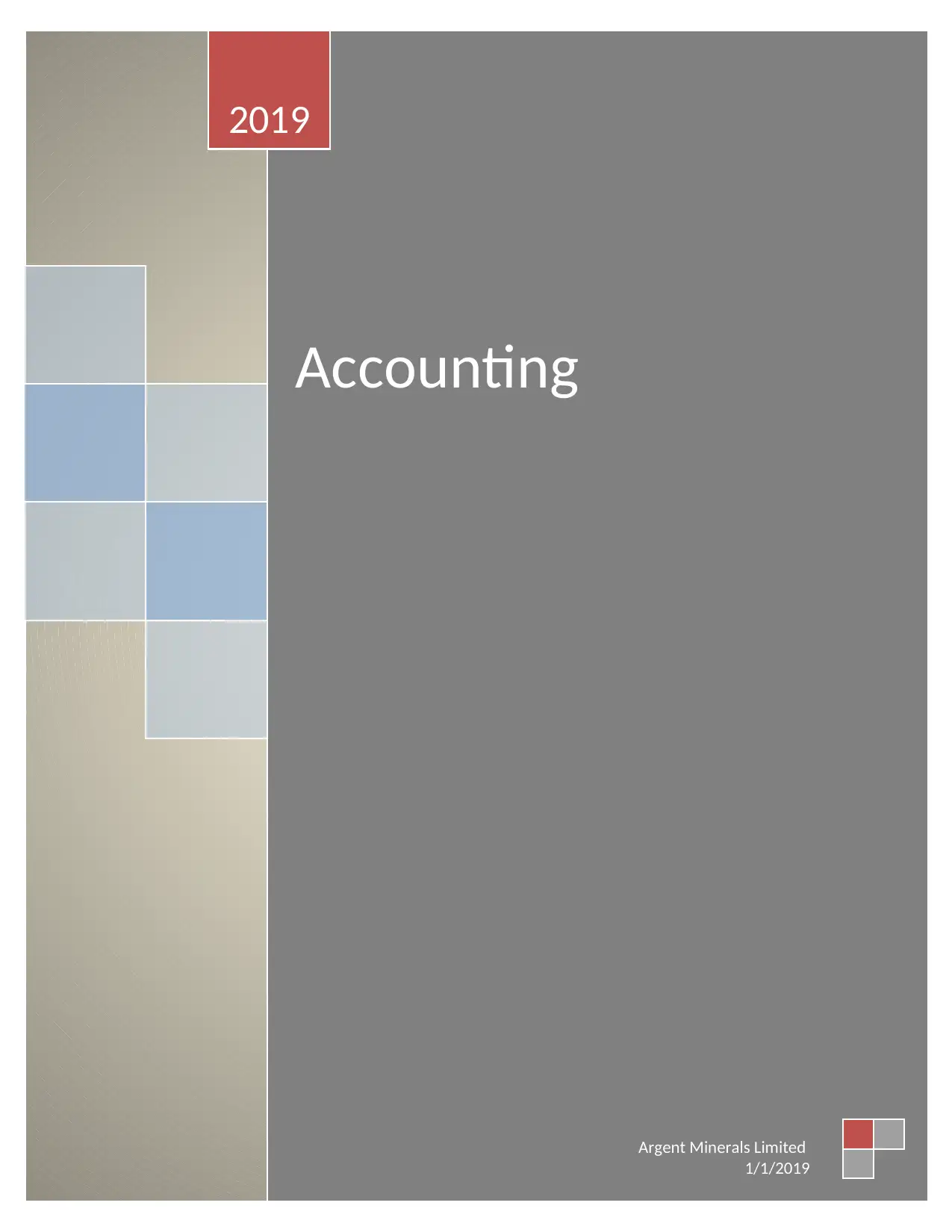
Accounting
2019
Argent Minerals Limited
1/1/2019
2019
Argent Minerals Limited
1/1/2019
Paraphrase This Document
Need a fresh take? Get an instant paraphrase of this document with our AI Paraphraser
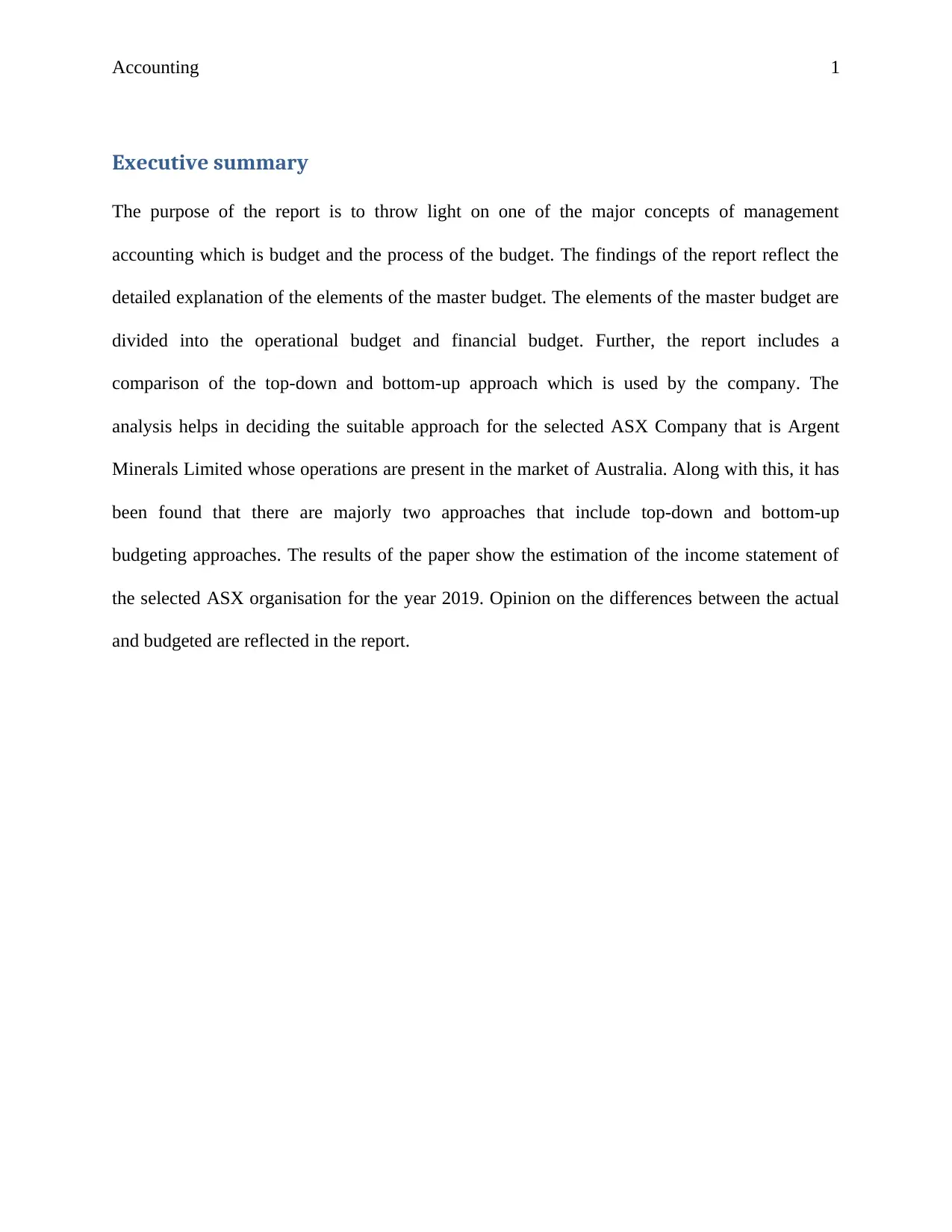
Accounting 1
Executive summary
The purpose of the report is to throw light on one of the major concepts of management
accounting which is budget and the process of the budget. The findings of the report reflect the
detailed explanation of the elements of the master budget. The elements of the master budget are
divided into the operational budget and financial budget. Further, the report includes a
comparison of the top-down and bottom-up approach which is used by the company. The
analysis helps in deciding the suitable approach for the selected ASX Company that is Argent
Minerals Limited whose operations are present in the market of Australia. Along with this, it has
been found that there are majorly two approaches that include top-down and bottom-up
budgeting approaches. The results of the paper show the estimation of the income statement of
the selected ASX organisation for the year 2019. Opinion on the differences between the actual
and budgeted are reflected in the report.
Executive summary
The purpose of the report is to throw light on one of the major concepts of management
accounting which is budget and the process of the budget. The findings of the report reflect the
detailed explanation of the elements of the master budget. The elements of the master budget are
divided into the operational budget and financial budget. Further, the report includes a
comparison of the top-down and bottom-up approach which is used by the company. The
analysis helps in deciding the suitable approach for the selected ASX Company that is Argent
Minerals Limited whose operations are present in the market of Australia. Along with this, it has
been found that there are majorly two approaches that include top-down and bottom-up
budgeting approaches. The results of the paper show the estimation of the income statement of
the selected ASX organisation for the year 2019. Opinion on the differences between the actual
and budgeted are reflected in the report.
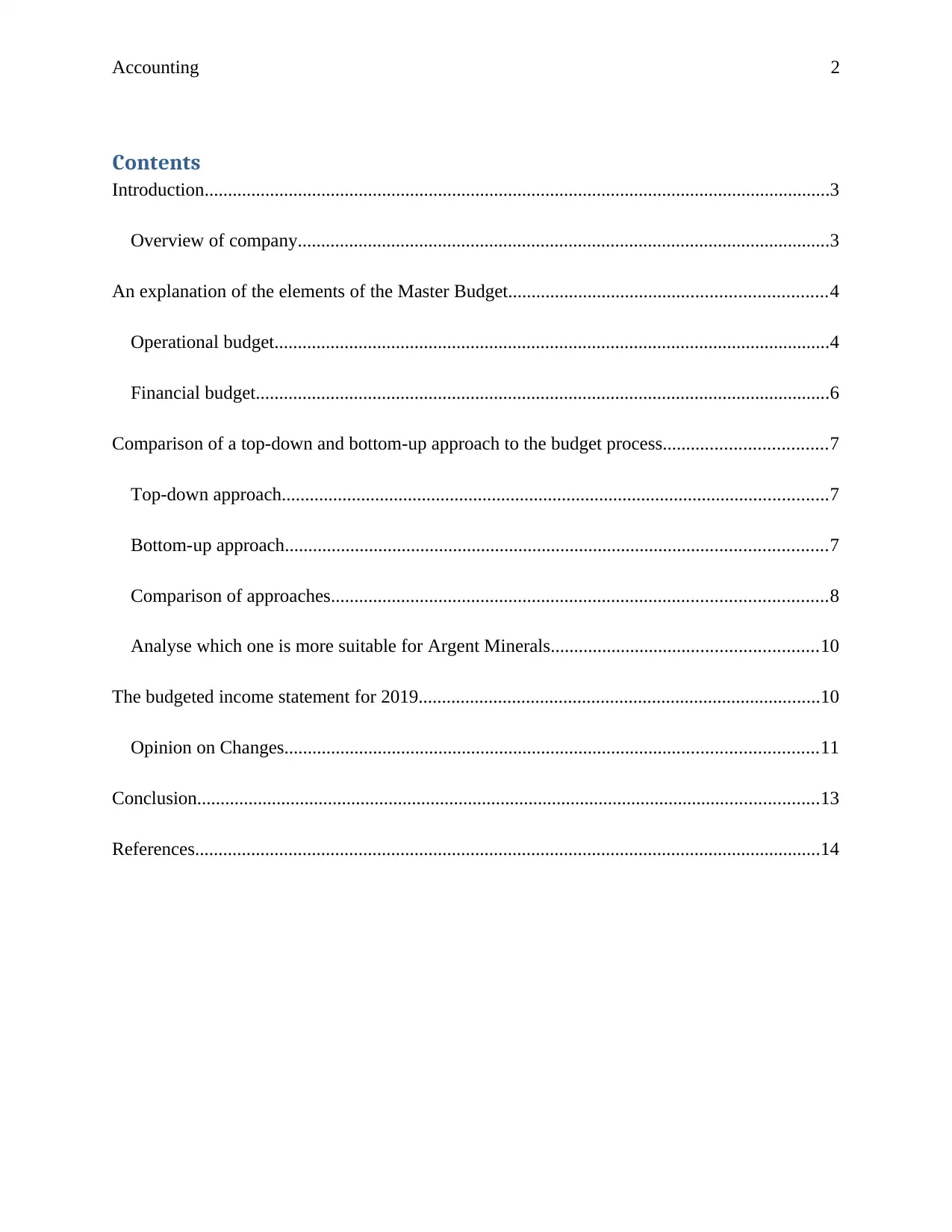
Accounting 2
Contents
Introduction......................................................................................................................................3
Overview of company..................................................................................................................3
An explanation of the elements of the Master Budget....................................................................4
Operational budget.......................................................................................................................4
Financial budget...........................................................................................................................6
Comparison of a top-down and bottom-up approach to the budget process...................................7
Top-down approach.....................................................................................................................7
Bottom-up approach....................................................................................................................7
Comparison of approaches..........................................................................................................8
Analyse which one is more suitable for Argent Minerals.........................................................10
The budgeted income statement for 2019......................................................................................10
Opinion on Changes..................................................................................................................11
Conclusion.....................................................................................................................................13
References......................................................................................................................................14
Contents
Introduction......................................................................................................................................3
Overview of company..................................................................................................................3
An explanation of the elements of the Master Budget....................................................................4
Operational budget.......................................................................................................................4
Financial budget...........................................................................................................................6
Comparison of a top-down and bottom-up approach to the budget process...................................7
Top-down approach.....................................................................................................................7
Bottom-up approach....................................................................................................................7
Comparison of approaches..........................................................................................................8
Analyse which one is more suitable for Argent Minerals.........................................................10
The budgeted income statement for 2019......................................................................................10
Opinion on Changes..................................................................................................................11
Conclusion.....................................................................................................................................13
References......................................................................................................................................14
⊘ This is a preview!⊘
Do you want full access?
Subscribe today to unlock all pages.

Trusted by 1+ million students worldwide
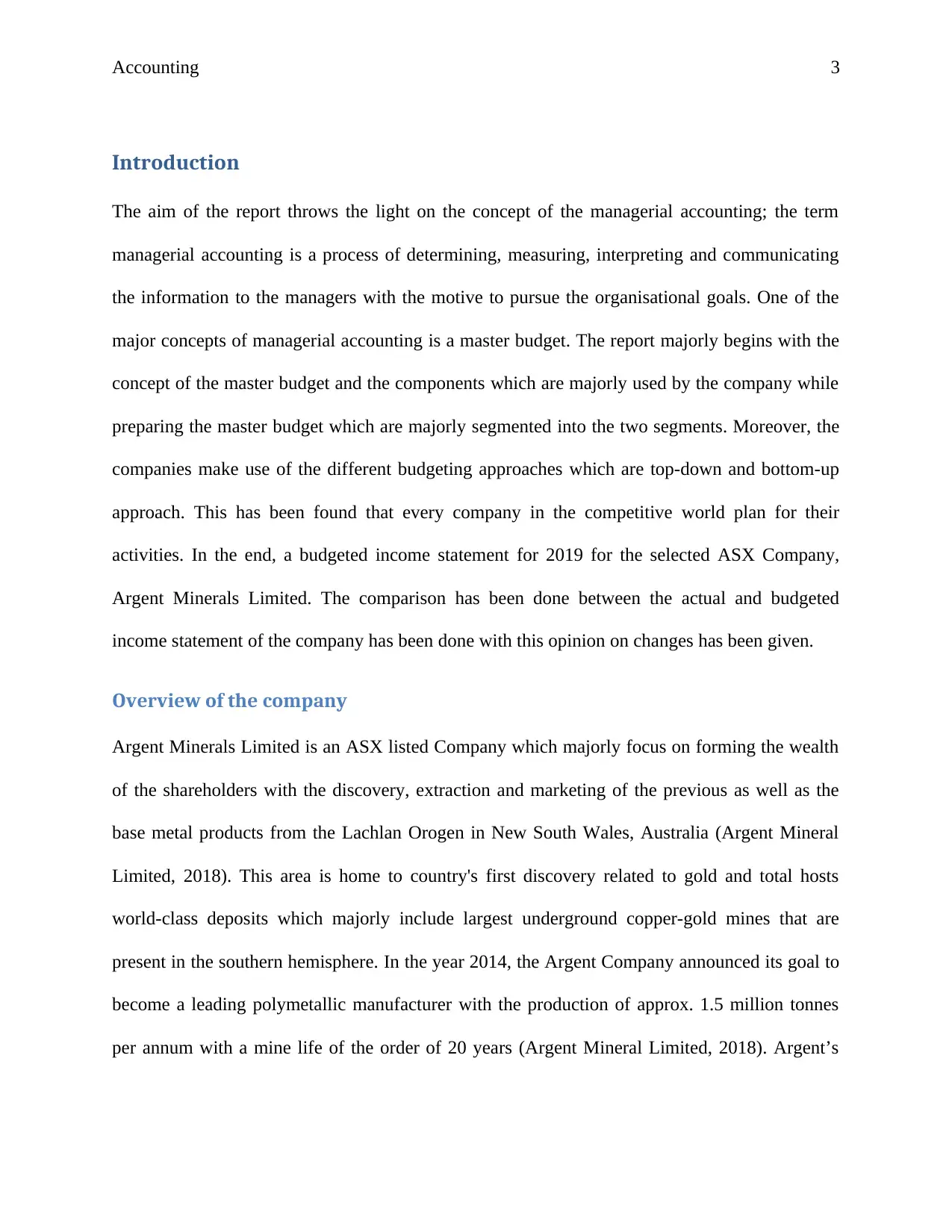
Accounting 3
Introduction
The aim of the report throws the light on the concept of the managerial accounting; the term
managerial accounting is a process of determining, measuring, interpreting and communicating
the information to the managers with the motive to pursue the organisational goals. One of the
major concepts of managerial accounting is a master budget. The report majorly begins with the
concept of the master budget and the components which are majorly used by the company while
preparing the master budget which are majorly segmented into the two segments. Moreover, the
companies make use of the different budgeting approaches which are top-down and bottom-up
approach. This has been found that every company in the competitive world plan for their
activities. In the end, a budgeted income statement for 2019 for the selected ASX Company,
Argent Minerals Limited. The comparison has been done between the actual and budgeted
income statement of the company has been done with this opinion on changes has been given.
Overview of the company
Argent Minerals Limited is an ASX listed Company which majorly focus on forming the wealth
of the shareholders with the discovery, extraction and marketing of the previous as well as the
base metal products from the Lachlan Orogen in New South Wales, Australia (Argent Mineral
Limited, 2018). This area is home to country's first discovery related to gold and total hosts
world-class deposits which majorly include largest underground copper-gold mines that are
present in the southern hemisphere. In the year 2014, the Argent Company announced its goal to
become a leading polymetallic manufacturer with the production of approx. 1.5 million tonnes
per annum with a mine life of the order of 20 years (Argent Mineral Limited, 2018). Argent’s
Introduction
The aim of the report throws the light on the concept of the managerial accounting; the term
managerial accounting is a process of determining, measuring, interpreting and communicating
the information to the managers with the motive to pursue the organisational goals. One of the
major concepts of managerial accounting is a master budget. The report majorly begins with the
concept of the master budget and the components which are majorly used by the company while
preparing the master budget which are majorly segmented into the two segments. Moreover, the
companies make use of the different budgeting approaches which are top-down and bottom-up
approach. This has been found that every company in the competitive world plan for their
activities. In the end, a budgeted income statement for 2019 for the selected ASX Company,
Argent Minerals Limited. The comparison has been done between the actual and budgeted
income statement of the company has been done with this opinion on changes has been given.
Overview of the company
Argent Minerals Limited is an ASX listed Company which majorly focus on forming the wealth
of the shareholders with the discovery, extraction and marketing of the previous as well as the
base metal products from the Lachlan Orogen in New South Wales, Australia (Argent Mineral
Limited, 2018). This area is home to country's first discovery related to gold and total hosts
world-class deposits which majorly include largest underground copper-gold mines that are
present in the southern hemisphere. In the year 2014, the Argent Company announced its goal to
become a leading polymetallic manufacturer with the production of approx. 1.5 million tonnes
per annum with a mine life of the order of 20 years (Argent Mineral Limited, 2018). Argent’s
Paraphrase This Document
Need a fresh take? Get an instant paraphrase of this document with our AI Paraphraser
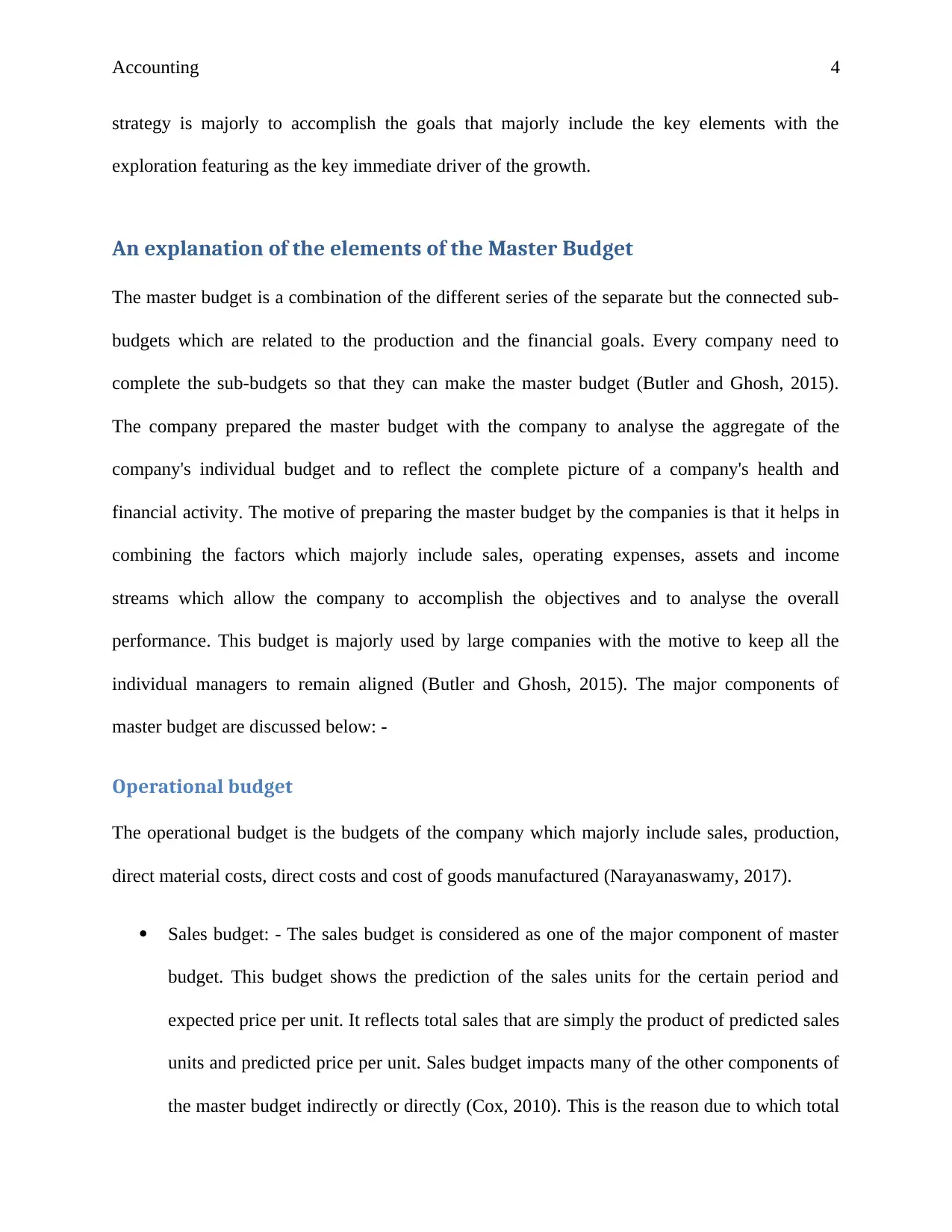
Accounting 4
strategy is majorly to accomplish the goals that majorly include the key elements with the
exploration featuring as the key immediate driver of the growth.
An explanation of the elements of the Master Budget
The master budget is a combination of the different series of the separate but the connected sub-
budgets which are related to the production and the financial goals. Every company need to
complete the sub-budgets so that they can make the master budget (Butler and Ghosh, 2015).
The company prepared the master budget with the company to analyse the aggregate of the
company's individual budget and to reflect the complete picture of a company's health and
financial activity. The motive of preparing the master budget by the companies is that it helps in
combining the factors which majorly include sales, operating expenses, assets and income
streams which allow the company to accomplish the objectives and to analyse the overall
performance. This budget is majorly used by large companies with the motive to keep all the
individual managers to remain aligned (Butler and Ghosh, 2015). The major components of
master budget are discussed below: -
Operational budget
The operational budget is the budgets of the company which majorly include sales, production,
direct material costs, direct costs and cost of goods manufactured (Narayanaswamy, 2017).
Sales budget: - The sales budget is considered as one of the major component of master
budget. This budget shows the prediction of the sales units for the certain period and
expected price per unit. It reflects total sales that are simply the product of predicted sales
units and predicted price per unit. Sales budget impacts many of the other components of
the master budget indirectly or directly (Cox, 2010). This is the reason due to which total
strategy is majorly to accomplish the goals that majorly include the key elements with the
exploration featuring as the key immediate driver of the growth.
An explanation of the elements of the Master Budget
The master budget is a combination of the different series of the separate but the connected sub-
budgets which are related to the production and the financial goals. Every company need to
complete the sub-budgets so that they can make the master budget (Butler and Ghosh, 2015).
The company prepared the master budget with the company to analyse the aggregate of the
company's individual budget and to reflect the complete picture of a company's health and
financial activity. The motive of preparing the master budget by the companies is that it helps in
combining the factors which majorly include sales, operating expenses, assets and income
streams which allow the company to accomplish the objectives and to analyse the overall
performance. This budget is majorly used by large companies with the motive to keep all the
individual managers to remain aligned (Butler and Ghosh, 2015). The major components of
master budget are discussed below: -
Operational budget
The operational budget is the budgets of the company which majorly include sales, production,
direct material costs, direct costs and cost of goods manufactured (Narayanaswamy, 2017).
Sales budget: - The sales budget is considered as one of the major component of master
budget. This budget shows the prediction of the sales units for the certain period and
expected price per unit. It reflects total sales that are simply the product of predicted sales
units and predicted price per unit. Sales budget impacts many of the other components of
the master budget indirectly or directly (Cox, 2010). This is the reason due to which total
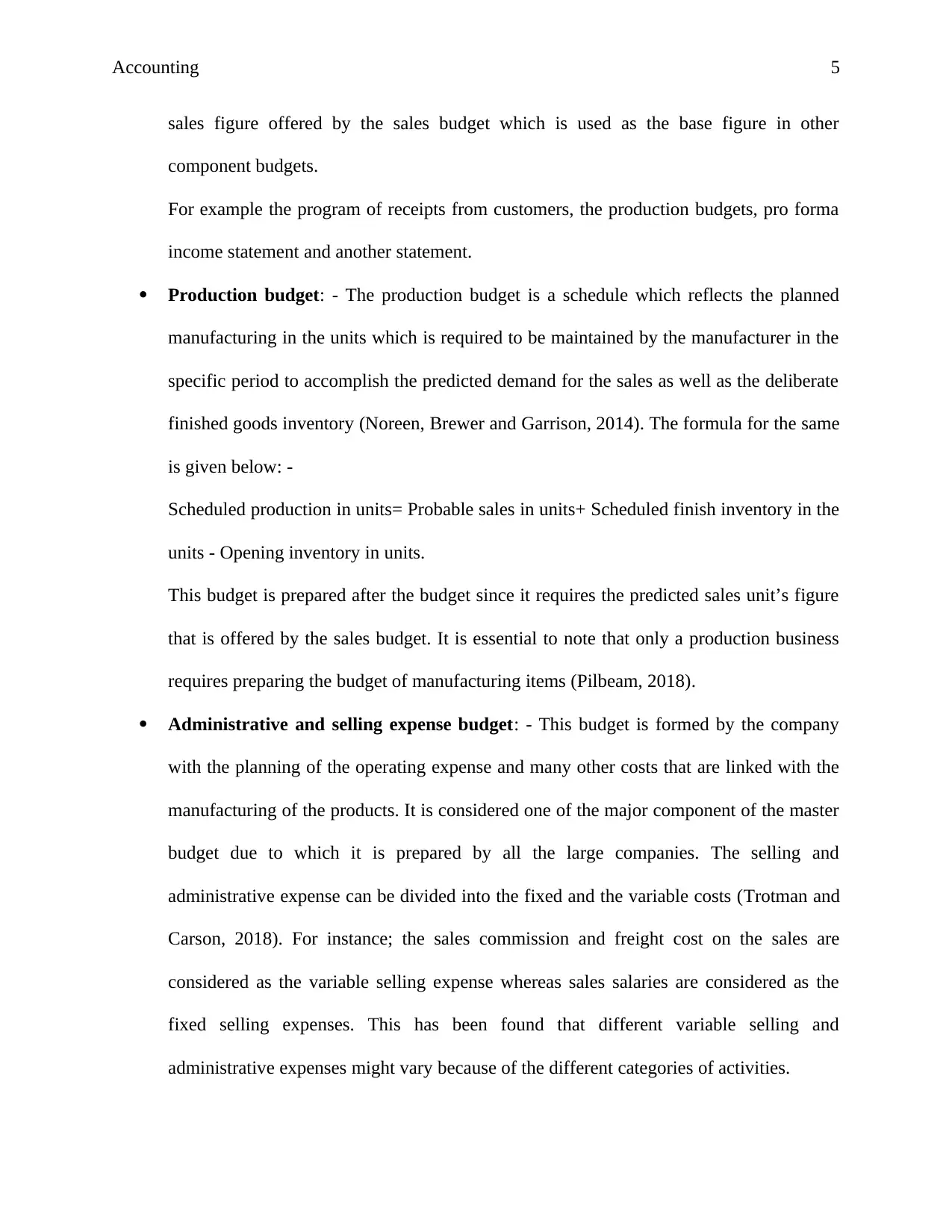
Accounting 5
sales figure offered by the sales budget which is used as the base figure in other
component budgets.
For example the program of receipts from customers, the production budgets, pro forma
income statement and another statement.
Production budget: - The production budget is a schedule which reflects the planned
manufacturing in the units which is required to be maintained by the manufacturer in the
specific period to accomplish the predicted demand for the sales as well as the deliberate
finished goods inventory (Noreen, Brewer and Garrison, 2014). The formula for the same
is given below: -
Scheduled production in units= Probable sales in units+ Scheduled finish inventory in the
units - Opening inventory in units.
This budget is prepared after the budget since it requires the predicted sales unit’s figure
that is offered by the sales budget. It is essential to note that only a production business
requires preparing the budget of manufacturing items (Pilbeam, 2018).
Administrative and selling expense budget: - This budget is formed by the company
with the planning of the operating expense and many other costs that are linked with the
manufacturing of the products. It is considered one of the major component of the master
budget due to which it is prepared by all the large companies. The selling and
administrative expense can be divided into the fixed and the variable costs (Trotman and
Carson, 2018). For instance; the sales commission and freight cost on the sales are
considered as the variable selling expense whereas sales salaries are considered as the
fixed selling expenses. This has been found that different variable selling and
administrative expenses might vary because of the different categories of activities.
sales figure offered by the sales budget which is used as the base figure in other
component budgets.
For example the program of receipts from customers, the production budgets, pro forma
income statement and another statement.
Production budget: - The production budget is a schedule which reflects the planned
manufacturing in the units which is required to be maintained by the manufacturer in the
specific period to accomplish the predicted demand for the sales as well as the deliberate
finished goods inventory (Noreen, Brewer and Garrison, 2014). The formula for the same
is given below: -
Scheduled production in units= Probable sales in units+ Scheduled finish inventory in the
units - Opening inventory in units.
This budget is prepared after the budget since it requires the predicted sales unit’s figure
that is offered by the sales budget. It is essential to note that only a production business
requires preparing the budget of manufacturing items (Pilbeam, 2018).
Administrative and selling expense budget: - This budget is formed by the company
with the planning of the operating expense and many other costs that are linked with the
manufacturing of the products. It is considered one of the major component of the master
budget due to which it is prepared by all the large companies. The selling and
administrative expense can be divided into the fixed and the variable costs (Trotman and
Carson, 2018). For instance; the sales commission and freight cost on the sales are
considered as the variable selling expense whereas sales salaries are considered as the
fixed selling expenses. This has been found that different variable selling and
administrative expenses might vary because of the different categories of activities.
⊘ This is a preview!⊘
Do you want full access?
Subscribe today to unlock all pages.

Trusted by 1+ million students worldwide
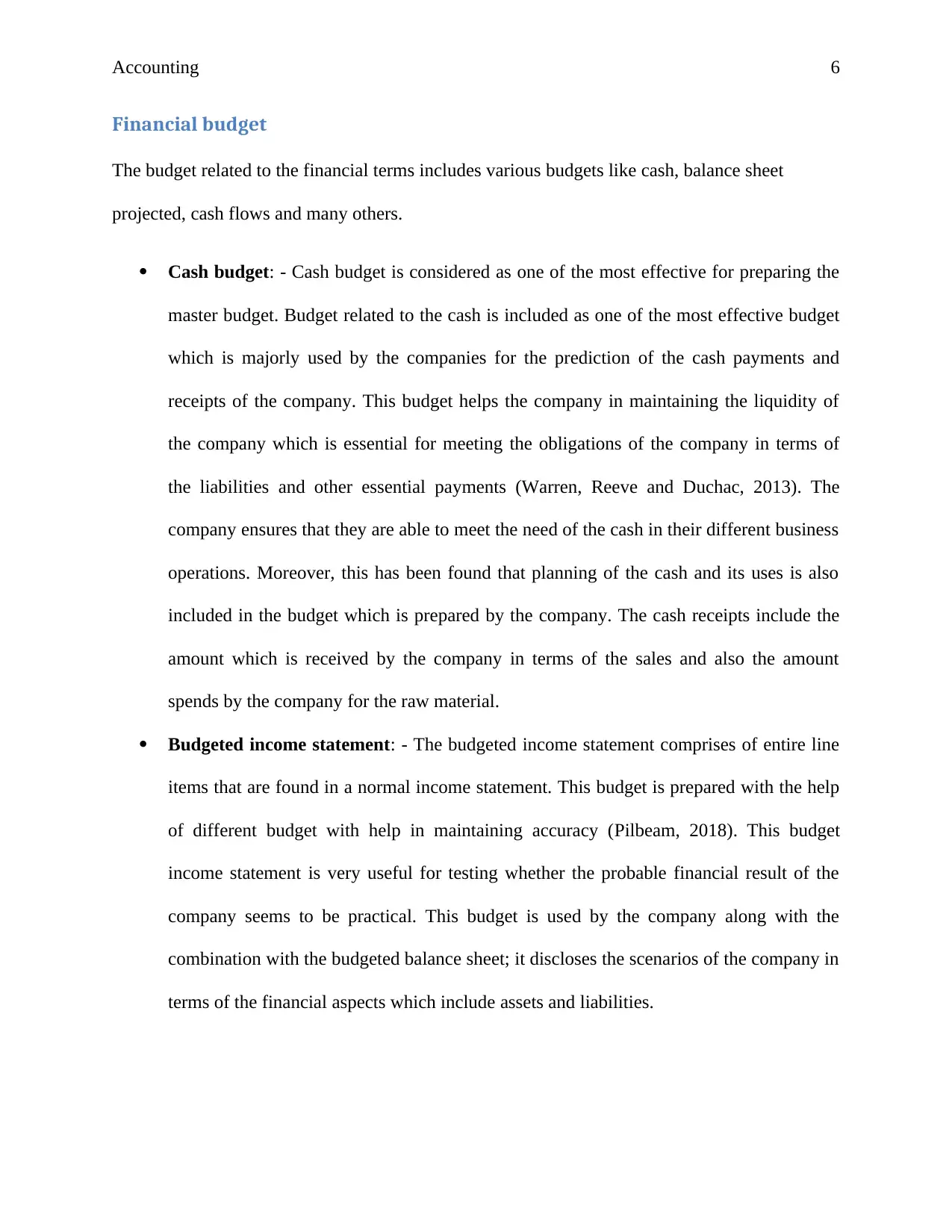
Accounting 6
Financial budget
The budget related to the financial terms includes various budgets like cash, balance sheet
projected, cash flows and many others.
Cash budget: - Cash budget is considered as one of the most effective for preparing the
master budget. Budget related to the cash is included as one of the most effective budget
which is majorly used by the companies for the prediction of the cash payments and
receipts of the company. This budget helps the company in maintaining the liquidity of
the company which is essential for meeting the obligations of the company in terms of
the liabilities and other essential payments (Warren, Reeve and Duchac, 2013). The
company ensures that they are able to meet the need of the cash in their different business
operations. Moreover, this has been found that planning of the cash and its uses is also
included in the budget which is prepared by the company. The cash receipts include the
amount which is received by the company in terms of the sales and also the amount
spends by the company for the raw material.
Budgeted income statement: - The budgeted income statement comprises of entire line
items that are found in a normal income statement. This budget is prepared with the help
of different budget with help in maintaining accuracy (Pilbeam, 2018). This budget
income statement is very useful for testing whether the probable financial result of the
company seems to be practical. This budget is used by the company along with the
combination with the budgeted balance sheet; it discloses the scenarios of the company in
terms of the financial aspects which include assets and liabilities.
Financial budget
The budget related to the financial terms includes various budgets like cash, balance sheet
projected, cash flows and many others.
Cash budget: - Cash budget is considered as one of the most effective for preparing the
master budget. Budget related to the cash is included as one of the most effective budget
which is majorly used by the companies for the prediction of the cash payments and
receipts of the company. This budget helps the company in maintaining the liquidity of
the company which is essential for meeting the obligations of the company in terms of
the liabilities and other essential payments (Warren, Reeve and Duchac, 2013). The
company ensures that they are able to meet the need of the cash in their different business
operations. Moreover, this has been found that planning of the cash and its uses is also
included in the budget which is prepared by the company. The cash receipts include the
amount which is received by the company in terms of the sales and also the amount
spends by the company for the raw material.
Budgeted income statement: - The budgeted income statement comprises of entire line
items that are found in a normal income statement. This budget is prepared with the help
of different budget with help in maintaining accuracy (Pilbeam, 2018). This budget
income statement is very useful for testing whether the probable financial result of the
company seems to be practical. This budget is used by the company along with the
combination with the budgeted balance sheet; it discloses the scenarios of the company in
terms of the financial aspects which include assets and liabilities.
Paraphrase This Document
Need a fresh take? Get an instant paraphrase of this document with our AI Paraphraser
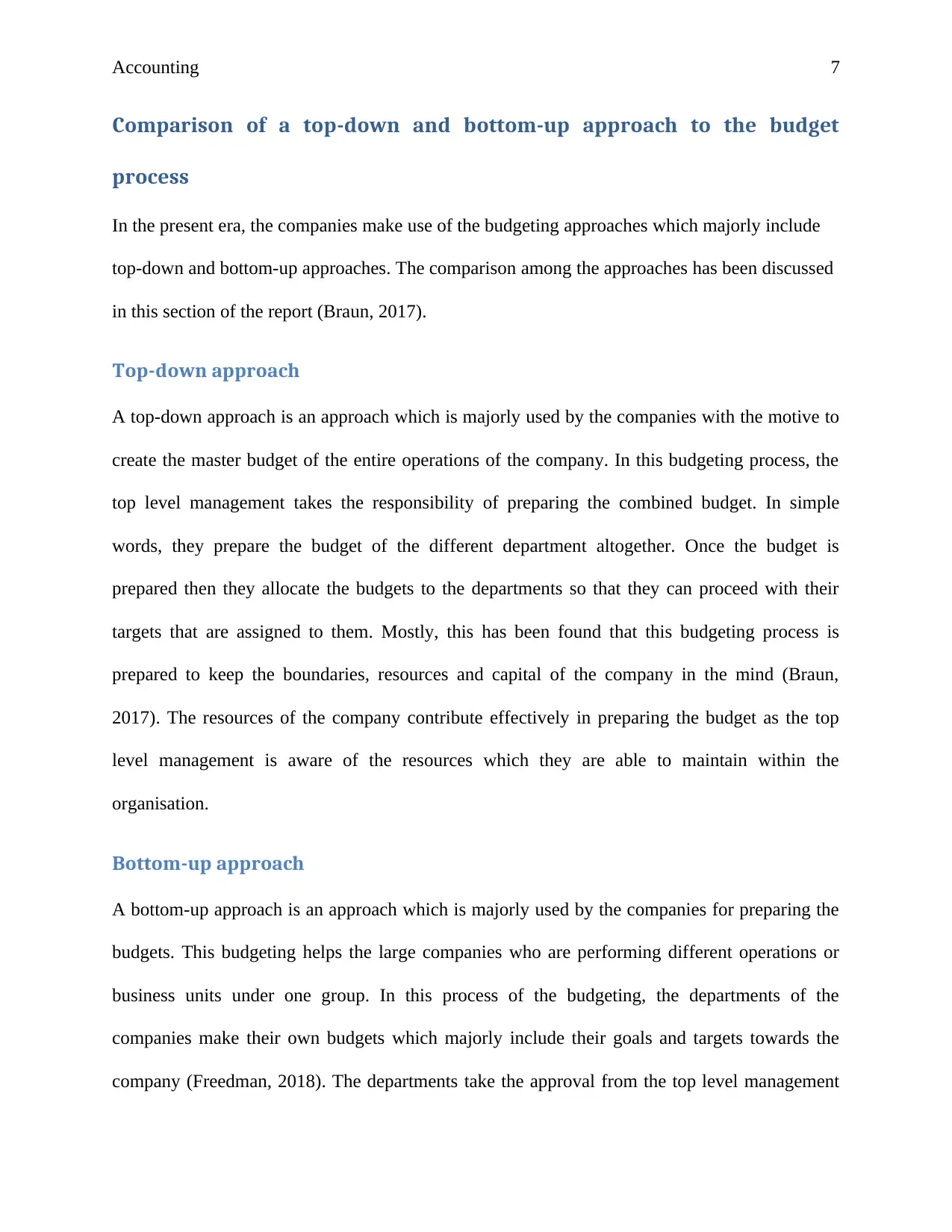
Accounting 7
Comparison of a top-down and bottom-up approach to the budget
process
In the present era, the companies make use of the budgeting approaches which majorly include
top-down and bottom-up approaches. The comparison among the approaches has been discussed
in this section of the report (Braun, 2017).
Top-down approach
A top-down approach is an approach which is majorly used by the companies with the motive to
create the master budget of the entire operations of the company. In this budgeting process, the
top level management takes the responsibility of preparing the combined budget. In simple
words, they prepare the budget of the different department altogether. Once the budget is
prepared then they allocate the budgets to the departments so that they can proceed with their
targets that are assigned to them. Mostly, this has been found that this budgeting process is
prepared to keep the boundaries, resources and capital of the company in the mind (Braun,
2017). The resources of the company contribute effectively in preparing the budget as the top
level management is aware of the resources which they are able to maintain within the
organisation.
Bottom-up approach
A bottom-up approach is an approach which is majorly used by the companies for preparing the
budgets. This budgeting helps the large companies who are performing different operations or
business units under one group. In this process of the budgeting, the departments of the
companies make their own budgets which majorly include their goals and targets towards the
company (Freedman, 2018). The departments take the approval from the top level management
Comparison of a top-down and bottom-up approach to the budget
process
In the present era, the companies make use of the budgeting approaches which majorly include
top-down and bottom-up approaches. The comparison among the approaches has been discussed
in this section of the report (Braun, 2017).
Top-down approach
A top-down approach is an approach which is majorly used by the companies with the motive to
create the master budget of the entire operations of the company. In this budgeting process, the
top level management takes the responsibility of preparing the combined budget. In simple
words, they prepare the budget of the different department altogether. Once the budget is
prepared then they allocate the budgets to the departments so that they can proceed with their
targets that are assigned to them. Mostly, this has been found that this budgeting process is
prepared to keep the boundaries, resources and capital of the company in the mind (Braun,
2017). The resources of the company contribute effectively in preparing the budget as the top
level management is aware of the resources which they are able to maintain within the
organisation.
Bottom-up approach
A bottom-up approach is an approach which is majorly used by the companies for preparing the
budgets. This budgeting helps the large companies who are performing different operations or
business units under one group. In this process of the budgeting, the departments of the
companies make their own budgets which majorly include their goals and targets towards the
company (Freedman, 2018). The departments take the approval from the top level management
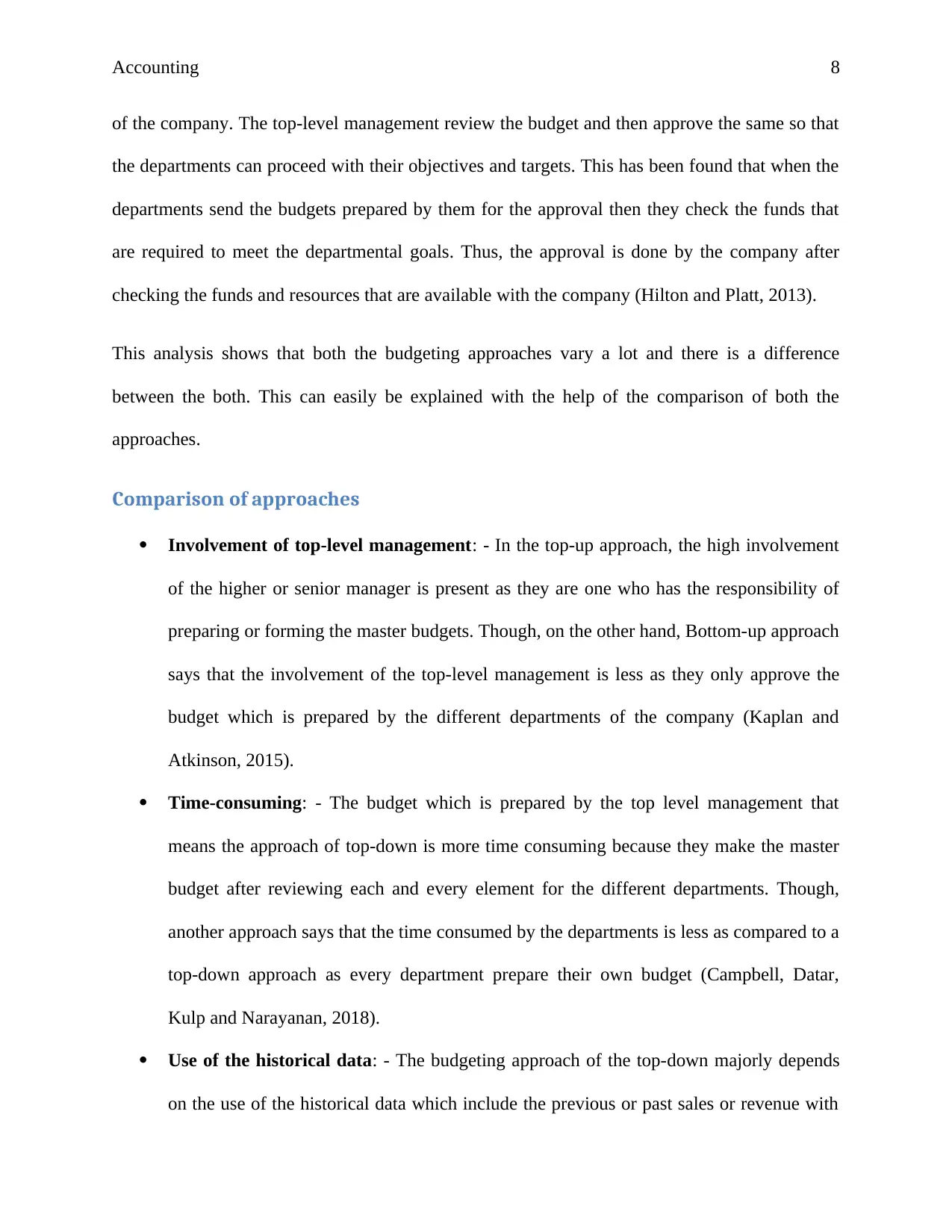
Accounting 8
of the company. The top-level management review the budget and then approve the same so that
the departments can proceed with their objectives and targets. This has been found that when the
departments send the budgets prepared by them for the approval then they check the funds that
are required to meet the departmental goals. Thus, the approval is done by the company after
checking the funds and resources that are available with the company (Hilton and Platt, 2013).
This analysis shows that both the budgeting approaches vary a lot and there is a difference
between the both. This can easily be explained with the help of the comparison of both the
approaches.
Comparison of approaches
Involvement of top-level management: - In the top-up approach, the high involvement
of the higher or senior manager is present as they are one who has the responsibility of
preparing or forming the master budgets. Though, on the other hand, Bottom-up approach
says that the involvement of the top-level management is less as they only approve the
budget which is prepared by the different departments of the company (Kaplan and
Atkinson, 2015).
Time-consuming: - The budget which is prepared by the top level management that
means the approach of top-down is more time consuming because they make the master
budget after reviewing each and every element for the different departments. Though,
another approach says that the time consumed by the departments is less as compared to a
top-down approach as every department prepare their own budget (Campbell, Datar,
Kulp and Narayanan, 2018).
Use of the historical data: - The budgeting approach of the top-down majorly depends
on the use of the historical data which include the previous or past sales or revenue with
of the company. The top-level management review the budget and then approve the same so that
the departments can proceed with their objectives and targets. This has been found that when the
departments send the budgets prepared by them for the approval then they check the funds that
are required to meet the departmental goals. Thus, the approval is done by the company after
checking the funds and resources that are available with the company (Hilton and Platt, 2013).
This analysis shows that both the budgeting approaches vary a lot and there is a difference
between the both. This can easily be explained with the help of the comparison of both the
approaches.
Comparison of approaches
Involvement of top-level management: - In the top-up approach, the high involvement
of the higher or senior manager is present as they are one who has the responsibility of
preparing or forming the master budgets. Though, on the other hand, Bottom-up approach
says that the involvement of the top-level management is less as they only approve the
budget which is prepared by the different departments of the company (Kaplan and
Atkinson, 2015).
Time-consuming: - The budget which is prepared by the top level management that
means the approach of top-down is more time consuming because they make the master
budget after reviewing each and every element for the different departments. Though,
another approach says that the time consumed by the departments is less as compared to a
top-down approach as every department prepare their own budget (Campbell, Datar,
Kulp and Narayanan, 2018).
Use of the historical data: - The budgeting approach of the top-down majorly depends
on the use of the historical data which include the previous or past sales or revenue with
⊘ This is a preview!⊘
Do you want full access?
Subscribe today to unlock all pages.

Trusted by 1+ million students worldwide
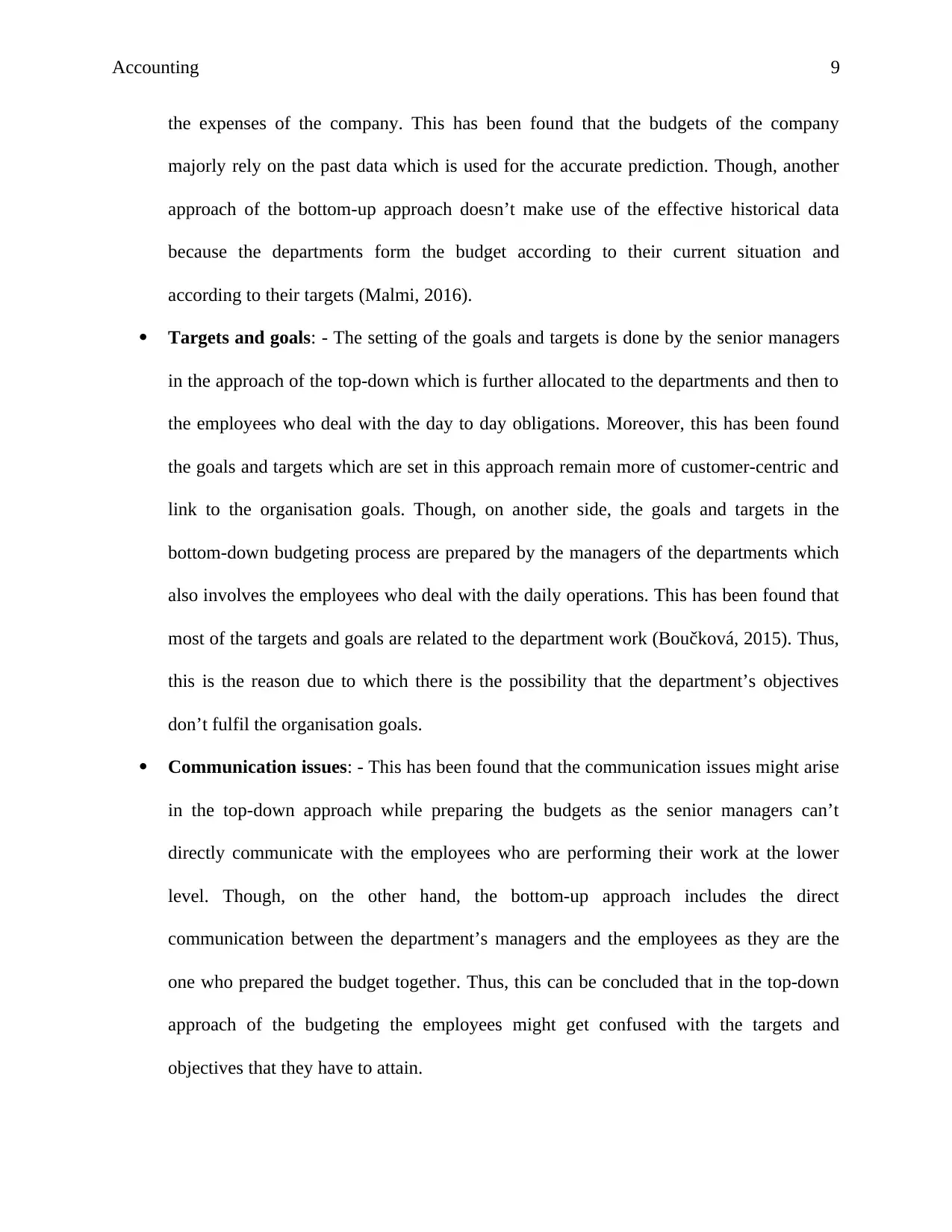
Accounting 9
the expenses of the company. This has been found that the budgets of the company
majorly rely on the past data which is used for the accurate prediction. Though, another
approach of the bottom-up approach doesn’t make use of the effective historical data
because the departments form the budget according to their current situation and
according to their targets (Malmi, 2016).
Targets and goals: - The setting of the goals and targets is done by the senior managers
in the approach of the top-down which is further allocated to the departments and then to
the employees who deal with the day to day obligations. Moreover, this has been found
the goals and targets which are set in this approach remain more of customer-centric and
link to the organisation goals. Though, on another side, the goals and targets in the
bottom-down budgeting process are prepared by the managers of the departments which
also involves the employees who deal with the daily operations. This has been found that
most of the targets and goals are related to the department work (Boučková, 2015). Thus,
this is the reason due to which there is the possibility that the department’s objectives
don’t fulfil the organisation goals.
Communication issues: - This has been found that the communication issues might arise
in the top-down approach while preparing the budgets as the senior managers can’t
directly communicate with the employees who are performing their work at the lower
level. Though, on the other hand, the bottom-up approach includes the direct
communication between the department’s managers and the employees as they are the
one who prepared the budget together. Thus, this can be concluded that in the top-down
approach of the budgeting the employees might get confused with the targets and
objectives that they have to attain.
the expenses of the company. This has been found that the budgets of the company
majorly rely on the past data which is used for the accurate prediction. Though, another
approach of the bottom-up approach doesn’t make use of the effective historical data
because the departments form the budget according to their current situation and
according to their targets (Malmi, 2016).
Targets and goals: - The setting of the goals and targets is done by the senior managers
in the approach of the top-down which is further allocated to the departments and then to
the employees who deal with the day to day obligations. Moreover, this has been found
the goals and targets which are set in this approach remain more of customer-centric and
link to the organisation goals. Though, on another side, the goals and targets in the
bottom-down budgeting process are prepared by the managers of the departments which
also involves the employees who deal with the daily operations. This has been found that
most of the targets and goals are related to the department work (Boučková, 2015). Thus,
this is the reason due to which there is the possibility that the department’s objectives
don’t fulfil the organisation goals.
Communication issues: - This has been found that the communication issues might arise
in the top-down approach while preparing the budgets as the senior managers can’t
directly communicate with the employees who are performing their work at the lower
level. Though, on the other hand, the bottom-up approach includes the direct
communication between the department’s managers and the employees as they are the
one who prepared the budget together. Thus, this can be concluded that in the top-down
approach of the budgeting the employees might get confused with the targets and
objectives that they have to attain.
Paraphrase This Document
Need a fresh take? Get an instant paraphrase of this document with our AI Paraphraser
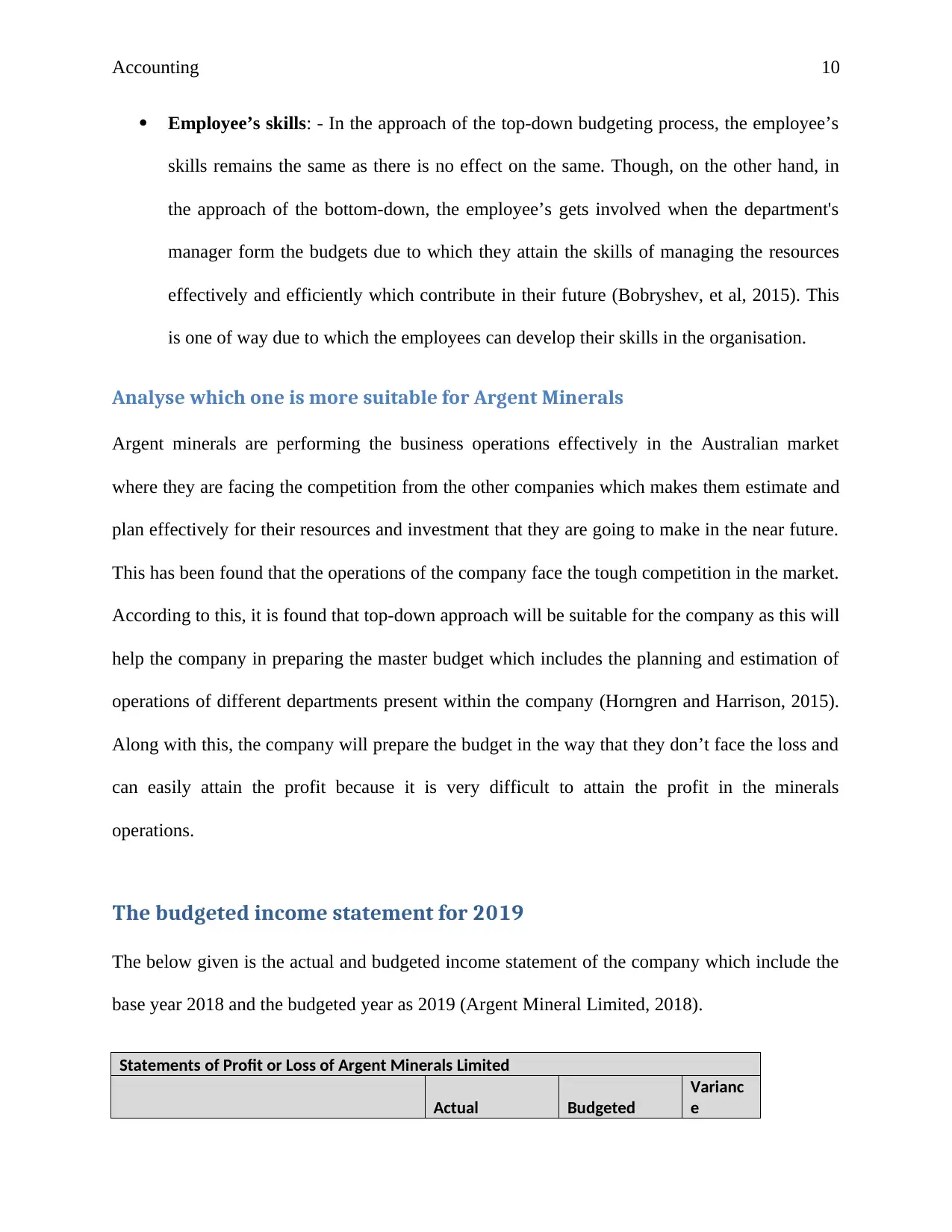
Accounting 10
Employee’s skills: - In the approach of the top-down budgeting process, the employee’s
skills remains the same as there is no effect on the same. Though, on the other hand, in
the approach of the bottom-down, the employee’s gets involved when the department's
manager form the budgets due to which they attain the skills of managing the resources
effectively and efficiently which contribute in their future (Bobryshev, et al, 2015). This
is one of way due to which the employees can develop their skills in the organisation.
Analyse which one is more suitable for Argent Minerals
Argent minerals are performing the business operations effectively in the Australian market
where they are facing the competition from the other companies which makes them estimate and
plan effectively for their resources and investment that they are going to make in the near future.
This has been found that the operations of the company face the tough competition in the market.
According to this, it is found that top-down approach will be suitable for the company as this will
help the company in preparing the master budget which includes the planning and estimation of
operations of different departments present within the company (Horngren and Harrison, 2015).
Along with this, the company will prepare the budget in the way that they don’t face the loss and
can easily attain the profit because it is very difficult to attain the profit in the minerals
operations.
The budgeted income statement for 2019
The below given is the actual and budgeted income statement of the company which include the
base year 2018 and the budgeted year as 2019 (Argent Mineral Limited, 2018).
Statements of Profit or Loss of Argent Minerals Limited
Actual Budgeted
Varianc
e
Employee’s skills: - In the approach of the top-down budgeting process, the employee’s
skills remains the same as there is no effect on the same. Though, on the other hand, in
the approach of the bottom-down, the employee’s gets involved when the department's
manager form the budgets due to which they attain the skills of managing the resources
effectively and efficiently which contribute in their future (Bobryshev, et al, 2015). This
is one of way due to which the employees can develop their skills in the organisation.
Analyse which one is more suitable for Argent Minerals
Argent minerals are performing the business operations effectively in the Australian market
where they are facing the competition from the other companies which makes them estimate and
plan effectively for their resources and investment that they are going to make in the near future.
This has been found that the operations of the company face the tough competition in the market.
According to this, it is found that top-down approach will be suitable for the company as this will
help the company in preparing the master budget which includes the planning and estimation of
operations of different departments present within the company (Horngren and Harrison, 2015).
Along with this, the company will prepare the budget in the way that they don’t face the loss and
can easily attain the profit because it is very difficult to attain the profit in the minerals
operations.
The budgeted income statement for 2019
The below given is the actual and budgeted income statement of the company which include the
base year 2018 and the budgeted year as 2019 (Argent Mineral Limited, 2018).
Statements of Profit or Loss of Argent Minerals Limited
Actual Budgeted
Varianc
e
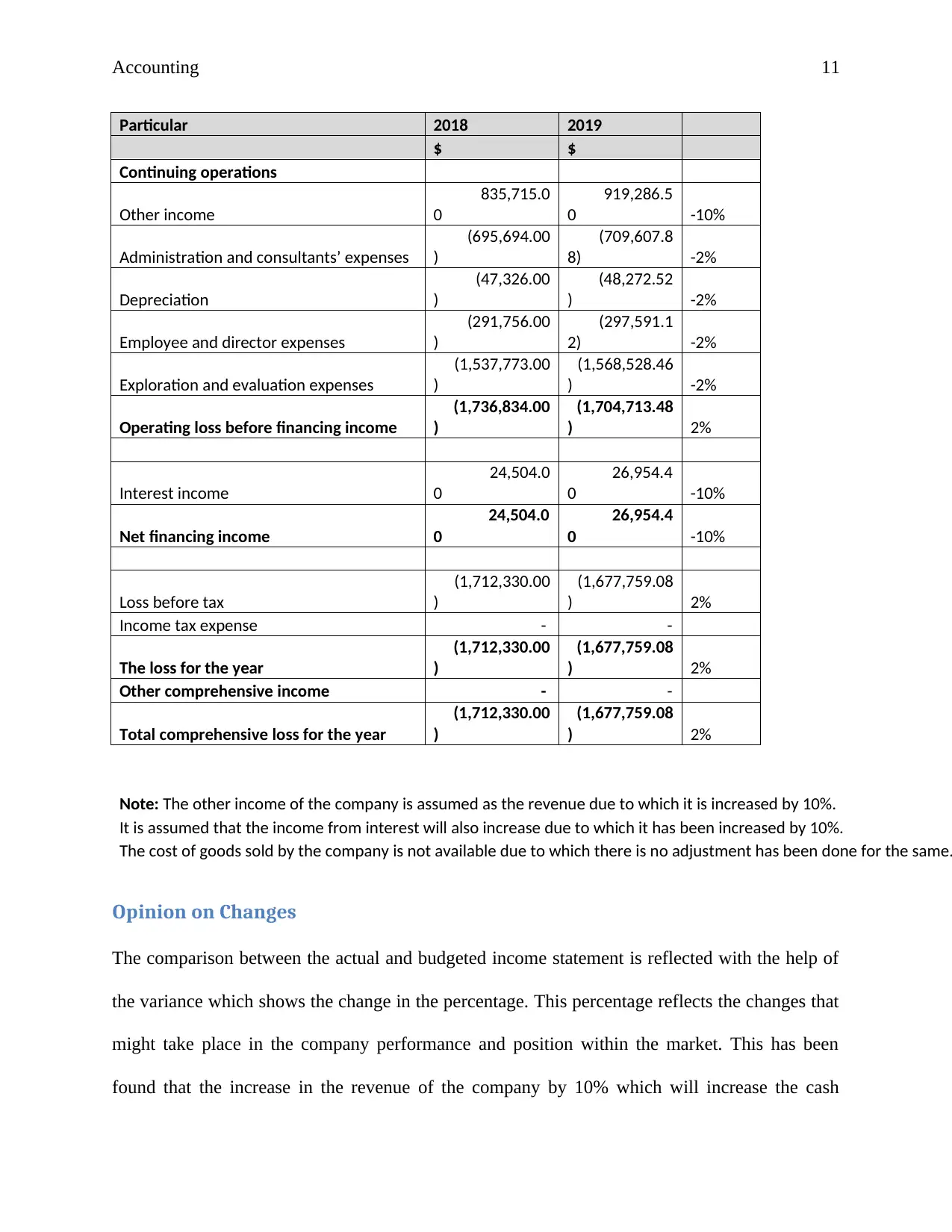
Accounting 11
Particular 2018 2019
$ $
Continuing operations
Other income
835,715.0
0
919,286.5
0 -10%
Administration and consultants’ expenses
(695,694.00
)
(709,607.8
8) -2%
Depreciation
(47,326.00
)
(48,272.52
) -2%
Employee and director expenses
(291,756.00
)
(297,591.1
2) -2%
Exploration and evaluation expenses
(1,537,773.00
)
(1,568,528.46
) -2%
Operating loss before financing income
(1,736,834.00
)
(1,704,713.48
) 2%
Interest income
24,504.0
0
26,954.4
0 -10%
Net financing income
24,504.0
0
26,954.4
0 -10%
Loss before tax
(1,712,330.00
)
(1,677,759.08
) 2%
Income tax expense - -
The loss for the year
(1,712,330.00
)
(1,677,759.08
) 2%
Other comprehensive income - -
Total comprehensive loss for the year
(1,712,330.00
)
(1,677,759.08
) 2%
Note: The other income of the company is assumed as the revenue due to which it is increased by 10%.
It is assumed that the income from interest will also increase due to which it has been increased by 10%.
The cost of goods sold by the company is not available due to which there is no adjustment has been done for the same.
Opinion on Changes
The comparison between the actual and budgeted income statement is reflected with the help of
the variance which shows the change in the percentage. This percentage reflects the changes that
might take place in the company performance and position within the market. This has been
found that the increase in the revenue of the company by 10% which will increase the cash
Particular 2018 2019
$ $
Continuing operations
Other income
835,715.0
0
919,286.5
0 -10%
Administration and consultants’ expenses
(695,694.00
)
(709,607.8
8) -2%
Depreciation
(47,326.00
)
(48,272.52
) -2%
Employee and director expenses
(291,756.00
)
(297,591.1
2) -2%
Exploration and evaluation expenses
(1,537,773.00
)
(1,568,528.46
) -2%
Operating loss before financing income
(1,736,834.00
)
(1,704,713.48
) 2%
Interest income
24,504.0
0
26,954.4
0 -10%
Net financing income
24,504.0
0
26,954.4
0 -10%
Loss before tax
(1,712,330.00
)
(1,677,759.08
) 2%
Income tax expense - -
The loss for the year
(1,712,330.00
)
(1,677,759.08
) 2%
Other comprehensive income - -
Total comprehensive loss for the year
(1,712,330.00
)
(1,677,759.08
) 2%
Note: The other income of the company is assumed as the revenue due to which it is increased by 10%.
It is assumed that the income from interest will also increase due to which it has been increased by 10%.
The cost of goods sold by the company is not available due to which there is no adjustment has been done for the same.
Opinion on Changes
The comparison between the actual and budgeted income statement is reflected with the help of
the variance which shows the change in the percentage. This percentage reflects the changes that
might take place in the company performance and position within the market. This has been
found that the increase in the revenue of the company by 10% which will increase the cash
⊘ This is a preview!⊘
Do you want full access?
Subscribe today to unlock all pages.

Trusted by 1+ million students worldwide
1 out of 17
Related Documents
Your All-in-One AI-Powered Toolkit for Academic Success.
+13062052269
info@desklib.com
Available 24*7 on WhatsApp / Email
![[object Object]](/_next/static/media/star-bottom.7253800d.svg)
Unlock your academic potential
Copyright © 2020–2025 A2Z Services. All Rights Reserved. Developed and managed by ZUCOL.





